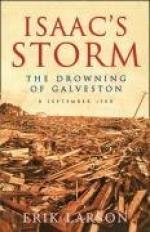
|
| Name: _________________________ | Period: ___________________ |
This quiz consists of 5 multiple choice and 5 short answer questions through Part I: The Law of Storms.
Multiple Choice Questions
1. According to the author in Part I: The Law of Storms, the first official notation of the storm was made by a Captain in his log on what date?
(a) July 4, 1899.
(b) August 27, 1900.
(c) September 20, 1902.
(d) June 18, 1901.
2. Who proved that air had mass, according to the author in Part I: The Law of Storms?
(a) Edison.
(b) Newton.
(c) Einstein.
(d) Aristotle.
3. Going back to the third century BC, who noted that "air" had substance, according to the author in Part I: The Law of Storms?
(a) The Egyptians.
(b) The Romans.
(c) The Byzantines.
(d) The Greeks.
4. The invention of the __________ was key to the development and effectiveness of the Weather Bureau allowing for the rapid transmission of weather forecasts from city to city.
(a) Camera.
(b) Train.
(c) Automobile.
(d) Telegraph.
5. What was the name of the captain who commanded the "Pensacola"?
(a) William B. Hazen.
(b) J. W. Simmons.
(c) William Sterett.
(d) T. P. Halsey.
Short Answer Questions
1. What college did Isaac Cline attend?
2. Who was the founder and first President of American Association for the Advancement of Science?
3. The author writes that low pressure lingered over ___________, and the air was heavy with moisture, causing trillions of water molecules to heat up.
4. What was the name of Isaac Cline's younger brother who lived with his family and worked for the weather service as an observer?
5. In Introduction: The Beach, Isaac had warnings from the central Weather Bureau that what location had been battered by a severe tropical storm?
|
This section contains 261 words (approx. 1 page at 300 words per page) |

|




